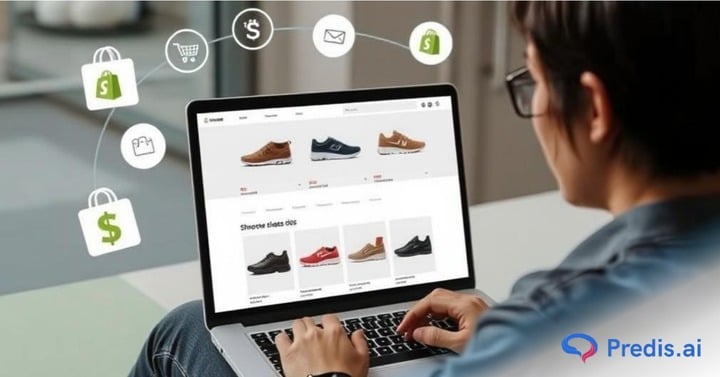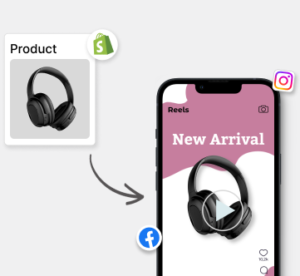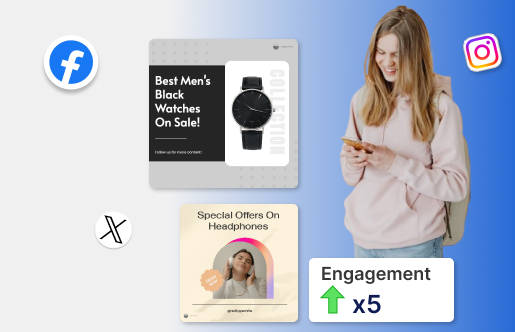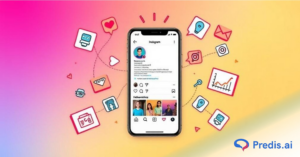Every business owner works hard to boost their sales and revenue. This can only occur if the conversion rate improves. To increase the conversion rate, make sure you’re talking to your customers in the right way. That’s where Omnichannel Ecommerce comes in.
Brands usually interact with their customers through different channels of communication such as phone calls, live chat, social media, and many more. But what if customers use different communication channels each time when they interact with the brand? It can be frustrating. Omnichannel Ecommerce fixes this. If a business uses an omnichannel eCommerce approach then it will save the customer data and interaction at whatever touchpoint the customer interacts with them to provide a unified experience in the buying journey.
Nowadays, it is crucial to provide your customers with what they want, when they want it, and where they want it. Customer expectations are rising every day. It ultimately puts more pressure on merchants and consumer goods firms to keep the promises they make to their customers. And this is the essence of omnichannel eCommerce and retailing.
Businesses are entering a new age with eCommerce sales. It is increasing by 25% in a single year and consumer expectations rising in tandem with revenues.
Updates that might have waited a few years are becoming increasingly necessary to do as quickly as possible. Developing an omnichannel eCommerce approach is undoubtedly one of them.
Whatever way you slice it, omnichannel eCommerce is here to stay, and it’s the correct step for many organizations. Hopefully, this information will assist you in determining whether it is the best option for you.
What is Omnichannel Ecommerce?
Omnichannel eCommerce refers to a sales method that employs different communication channels. It majorly focuses on providing a consistent buying experience to customers regardless of whether the purchase is done through in-store kiosks or other digital channels.
Businesses with an efficient omnichannel eCommerce strategy not only focus on the individual customer experiences on different channels but also on the complete customer buying experience. The final purchasing choice is made based on the information gathered by consumers from various sources.
Why Choose Omnichannel Ecommerce
Major businesses that are shifting to omnichannel eCommerce are witnessing significant benefits. Having an omnichannel eCommerce platform impacts the business by providing excellent omnichannel customer care and increasing brand reputation.
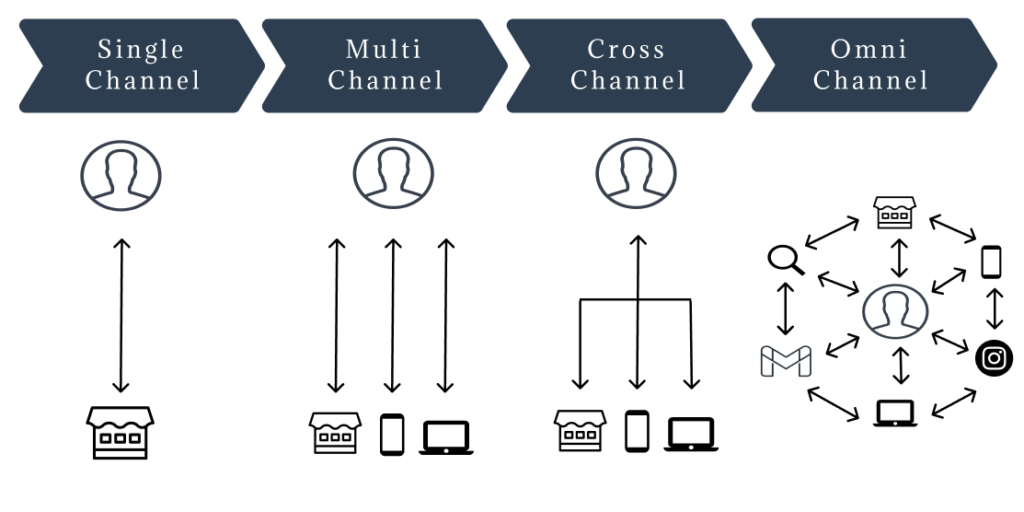
Brands that provide an omnichannel eCommerce platform can provide amazing solutions to their consumers while also experiencing major benefits to their business.
The following are the primary reasons why brands should migrate to an omnichannel eCommerce platform:
1. Improves Lead Conversion: Having an omnichannel eCommerce strategy in place aids in analyzing customer buying behavior and creating stronger customer connections, both of which directly increase sales.
2. Allows You To Understand Customer Journey Better: Businesses can use omnichannel eCommerce to acquire and combine consumer data from many channels. To execute this effectively, many companies rely on Salesforce implementation services to unify customer data, streamline workflows, and ensure smoother cross channel experiences. The combined insights provide a complete picture of the sorts of clients interested in your business, as well as their behavior, which aids in personalizing the customer experience.
3. Delivers A Consistent Brand Message: The goal of providing omnichannel eCommerce solutions is to provide customers with a consistent message about your business. The messaging remains the same regardless of where a client contacts your business.
4. Offers Personalized Customer Experience: A detailed grasp of the customer journey may assist you in personalizing the experience of your customers. Providing a tailored experience is critical for multichannel clients, who have a 30% greater lifetime value than shoppers who exclusively purchase through one channel.
Key Components For Building A Robust Omnichannel Ecommerce Strategy
Omnichannel eCommerce marketing ensures a seamless buying experience for customers from the first to the final touchpoint. It is independent of the communication channel. It emphasizes establishing your brand’s visibility across all offline and online platforms.
To gain and keep consumers, it’s critical to use omnichannel marketing. Ecommerce business owners can provide an outstanding buying experience to customers throughout their journey. It will ultimately help in delivering an improved omnichannel eCommerce customer experience.
Now that we’ve thoroughly examined what omnichannel eCommerce is and its primary benefits. Let’s move on to the essential components of developing a solid omnichannel eCommerce strategy.
1. Map Your Customer Journey
While there will not be a single trip that every client takes from discovering your brand to purchasing a product to raving about it on social media, it is beneficial to begin describing numerous potential journeys they may take.
To begin, define the various stages of your consumers’ purchasing behavior — problem recognition, curiosity, research, purchase, and so forth.
Once you’ve done that, you can begin to deconstruct why they’re interacting with you at each level, as well as what their goal is – research, comparison, purchase – and begin making it simpler for them to reach those goals.
Creating client personas is an excellent method to begin analyzing where and why they are connecting with you. Moreover, if you want some help, you can work with experts like Patryk Miszczak who can help with this.
For example, if your clients are discovering you through Instagram, but older customers are more likely to discover you through Google search results.
Now, put everything together and create a customer journey map. Each touchpoint throughout their journey is an opportunity to communicate with them in a way that improves their experience and increases their likelihood of conversion – and the key to it all is knowing that every channel in your plan counts.
2. Segment Your Audience
Omnichannel eCommerce marketing requires a thorough understanding of your customers. Customers’ online purchase behavior and decisions must be known in addition to their age, gender, and location. What methods do they utilize to contact you? Additionally knowing your customers’ behavior will allow you to customize the purchasing experience of your online store.
When you thoroughly research your clients, segmenting them becomes second nature. Client segmentation is crucial because it allows you to improve communication and customize the customer journey. Customers might be segmented based on their interests and purchasing habits. The more exact the audience segmentation, the more influential the omnichannel eCommerce marketing approach.
However, you do not need to customize your messaging for each unique consumer. Instead, divide your audience into smaller groups that share similar characteristics. These characteristics include:
- Demographics
- Preferred Communication Channels
- Customer Spendings
- Shopping Patterns
- Favorite Products
Personalization tactics may also be utilized in retail establishments. While proposing relevant goods online may be more difficult, using kiosks in kiosk mode or arming shopping assistants with mobile devices might help replicate the in-store internet experience.
3. Define The Specific Purpose of All Your Channel
So far, we’ve concentrated on selling through numerous channels because it is the core of omnichannel. But it’s crucial to note that you don’t have to use every channel to sell things directly to your consumers.
After you’ve decided on all of the channels where you want to be present, decide what each one’s objective will be – selling or not.
Defining the goal of each channel also entails committing to generating material for each of those channels. It is not just reposting the same stuff everywhere but developing content that is customized to each platform.
A one-size-fits-all strategy will not produce consistent outcomes from one channel to the next.
Not only does each network have its own set of best practices for content, but your audience will utilize each platform in a different way. Your material should live up to their expectations for the channel on which it appears.
Why would you want your content to be the same when the channels are different, the users and user expectations are different, and your consumer base is different?
Create brand Slogans for Ecommerce that help you to convey your business, product, benefits and features. With the help of Predis.ai AI Ecommerce Brand Slogan Generator.
4. Select Efficient Customer Engagement Tools
It’s not the time to throw darts at a board and pick whichever platforms land on them. But it’s also not a good idea to assume that the most popular ones will be the greatest choice.
It is when you leverage your consumer expertise, research your client personas, and connect them with platform demographics to discover the best fit.
The technologies that may be utilized to improve the omnichannel customer experience across several touchpoints.
- Chatbots – Use WhatsApp chatbots to interact with customers 24/7 and to provide real-time solutions to basic queries.
- Live chat – With live chat, you can provide real-time assistance to sales or support-related issues and increase client satisfaction.
- Visual engagement tools – Using tools such as co-browsing and video chat, you can have a direct dialogue that aids in identifying the issue and providing specific solutions.
- AI receptionists – AI receptionists serve as automated frontliners who capture customer intent, offer instant replies on digital channels, and hand off to chatbots or agents when needed.
Provide real-time responses and efficient solutions by utilizing digital technologies and client interaction tactics. You can improve your existing consumer relationships and enhance brand loyalty.
While you’re planning your approach, make use of marketing automation solutions. Marketing automation solutions can assist you in segmenting your audience. You may even modify the messaging and schedule social media updates. Marketing automation technologies also allow you to assess the effectiveness of your marketing initiatives.
You may and save time, money and enhance your marketing efficiency by using marketing automation technologies.
5. Make Your Website Mobile-Friendly
Honestly, whether you sell on your own website or not, you should optimize it for mobile. Anyone who accesses your website on their phone, customer or not, should be greeted with a personalized experience.
A successful mobile website is simple and easy to use, with clearly labeled and separate parts, accessible buttons, and a simple search box. You want your viewers to be able to discover what they’re looking for as soon and readily as feasible.
6. Create Quality Content
Using the handy map you just made for yourself, you can begin creating focused content that corresponds with the platform in question and assists you in achieving your goals on those platforms.

Here are some pointers to help you make your material more interesting.
- Take some great product images of a new line you want to advertise on Instagram to get your consumers excited about the new launch and to keep them updated on when it goes online.
- Behind-the-scenes footage: Use trending audio and demonstrate intriguing elements of the process that people would be interested in viewing on TikTok.
- Create some enticing email subject lines for your next email marketing campaign to A/B test.
Whatever you generate, all of your content should be able to relate back to the customer journey and customer goals.
To make your social media content creation easy. Use Predis.ai’s Ecommerce Social Media Post Maker and elevate your online presence with eye-catching social media posts.
Boost Sales on Social Media with AI ⚡️
TRY NOW7. Apply Omnichannel At Every Touchpoint
Customers should be able to purchase wherever they interact with your business when they have an omnichannel eCommerce experience. Your internet and physical storefronts are obvious, but can they make purchases through social media or your app?

This was not conceivable a few years ago. Thanks to some important upgrades on the main social media sites. It is now feasible to drive sales through Instagram, Facebook, and Pinterest.
But don’t stop there. If suitable, consider broadening your reach to markets such as Amazon and Etsy. Marketplaces have the second-largest percentage of customers and produce the greatest sales, as shown in the breakdown of omnichannel eCommerce expenditure above.
Sure, in an ideal world, clients would buy your things through your own website. Customers who buy from Amazon allow you to interact with them and bring them to your website.
The most common error firms make when establishing an omnichannel eCommerce strategy is focusing just on sales. Sure, sales are vital, but so are all other aspects of your organization, and they must all be omnichannel.
When a customer has a question regarding a product, they don’t hesitate to ask them about it over social media.
8. Gather Data Insights and Keep Testing
Over time, your multichannel e-commerce marketing plan will need to change. Consumer habits shift, new channels arise, and established platforms lose traction. That is why it is critical to collect data and continue to test and enhance your approach.
You will only be able to leverage analytics and data about your clients if they are connected across all channels. When your analytics are linked across all channels, you can create more fully-rounded client profiles as you grow to know them better, as well as more informed customer journeys.
More data enables you to optimize your campaign and, as a result, be more effective. Run live A/B tests on your customized messaging to each consumer segment and test your campaign as a whole. Changes to headlines, body content, and graphics may have a significant impact on engagement and conversion rates.
As is customary, this is not a “set it and forget it” scenario.
Instead, do your best to make changes as smoothly as possible and resolve speed bumps as they arise. Apart from this, begin iterating once you’re comfortable. The only way to tell if your existing approaches are as effective as they can be is to compare them to others.
Create click-magnet eCommerce ads that convert with Predis.ai's Ecommerce Ad Maker—make your products shine and improve campaign performance.
Effortless blending of digital and physical platforms
The effortless blending of digital and physical platforms in omnichannel ecommerce is all about efficient inventory management and offering convenient services like click-and-collect.
By implementing these strategies, you’re not just boosting your retail sales; you’re also enhancing the overall shopping experience for your customers.
Unified Inventory Management
One of the fundamental aspects of omnichannel ecommerce is the unified inventory management system. Here’s why it’s crucial:
- Implement a Centralized Inventory Management System: To succeed in omnichannel retail, you need a centralized inventory management system. This means that all your stock levels across online and offline stores are managed from a single hub. Technologies like RFID for inventory management can help automate tracking and provide real-time visibility across all channels.
- Enable Real-Time Inventory Updates: With this system, you can have real-time updates on your inventory. This prevents the nightmare of overselling or running out of products. Imagine never having to apologize to a customer for a sold-out item again!
Click-and-Collect Services
Click-and-collect services are another way to effortlessly blend your digital and physical platforms. Here’s how they work:
- Offer the Option for Customers to Buy Online and Pick Up In-Store: This service allows your customers to make purchases online and then choose to pick up their items from your physical store. It’s the best of both worlds – the convenience of online shopping with the immediacy of in-store pickup.
- Provide a Seamless and Convenient Experience: To make this process truly effortless, streamline your click-and-collect service. Ensure that the pickup process is swift and hassle-free. Your customers will appreciate the convenience, and you’ll boost foot traffic to your brick-and-mortar locations.
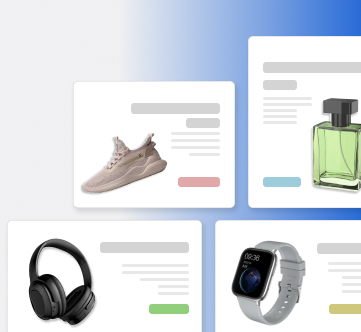
Wrapping It Up
Omnichannel eCommerce is sometimes thrown in with other eCommerce buzzwords, but it is far from a passing fad. It was gaining traction even before the worldwide epidemic caused people to stay at home and purchase online. So the last year has indeed been the final push to propel omnichannel to the forefront.
However, it is not the best option for every business. If you’re OK with selling on one platform without sophisticated statistics, there’s no need to revamp your approach.
However, it may be worth the effort for organizations trying to extend into new channels while increasing efficiency and conversion.
Follow Predis.ai on Instagram for more updates on social media!
Look out for some more eCommerce Solutions?
The environment is always changing, with new ideas appearing on a daily basis. Ecommerce World offers one-stop services to any eCommerce company, from growing business ideas to upgrading the company profile, and we assist companies throughout the business journey with our skills and knowledge. Here are some of the more effective eCommerce solutions covered by us that will give an ultimate boost to your retail sales:
- 12 Noteworthy Shopify Marketing Strategies To Boost Your ROI
- Shopping Cart Abandonment: 11 Effective Ways To Reduce It
Related Content,
Top Tips & Examples for Checkout Page Designs for eCommerce Store
Creating an E-Commerce Sales Funnel to Boost Conversions
Top Retail Ad Examples for Inspiration


